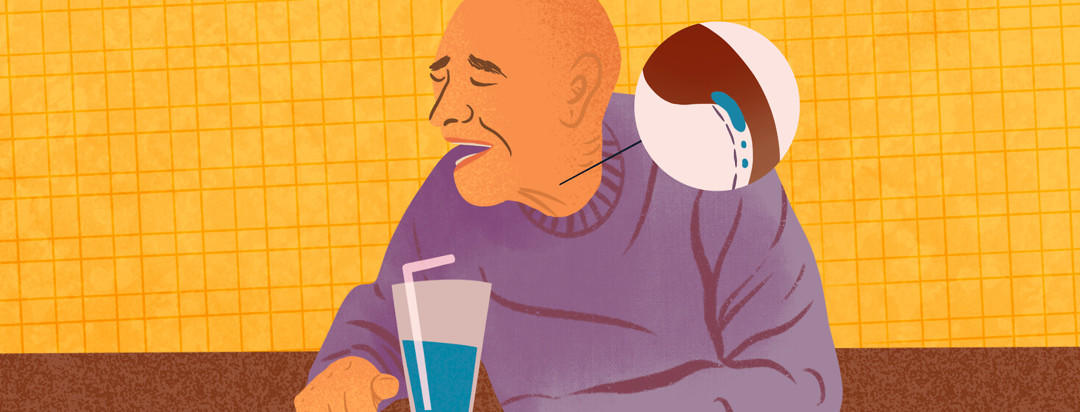Dysphagia in Parkinson's Disease
Dysphagia is the medical term used to describe difficulty swallowing. When Parkinson’s disease (PD) affects the muscles in the face, neck, or throat, it can cause dysphagia.1
More than 80 percent of people with PD experience dysphagia. Dysphagia can begin at any point during PD, but it tends to get more serious as the condition progresses.1,2
Signs and symptoms
Early intervention for dysphagia is important. Beginning treatment early can reduce your risk of complications and death. Some symptoms of dysphagia may not be obvious, but being aware of them can help you detect possible signs of the condition early on, such as:1,3
- Weight loss
- Difficulty drinking or keeping liquids and food in your mouth
- Drooling
- Coughing or choking during eating
- A feeling of food stuck in your throat or gum line
- Heartburn or sore throat after eating
Risks associated with dysphagia
Many people can find dysphagia embarrassing or frustrating. Difficulty swallowing can impact your quality of life, but it can also have serious effects.2
Dysphagia can cause malnutrition or dehydration. It can also cause aspiration, the medical term for “food going down the wrong pipe.” Aspiration can lead to aspiration pneumonia, which is the leading cause of death for people with PD. This is a type of lung infection that occurs when food, saliva, liquids, or vomit is breathed into the lungs or airways leading into the lungs, instead of being swallowed.1
Treatment and therapy options
If you are worried about dysphagia, a good first step is to speak with your neurologist. Your neurologist can recommend a speech-language pathologist (SLP). The SLP will examine you and recommend therapy or treatment options.1
An examination will likely include a questionnaire and imaging test. During the imaging test, the SLP will use a video X-ray or a small camera in your nose to watch you eat and drink. Your SLP may also give you a water swallowing test. In this test, your SLP determines how much water you can easily drink. These exams show your SLP where problems are happening and help them recommend options for you.2
There are different types of therapy your SLP may recommend. One method is the Lee Silverman Voice Technique (LSVT). The LSVT was first designed as a therapy to help people with speaking difficulties from PD. However, the therapy can also help people swallow safely. The LSVT is a regular regimen that emphasizes exaggerated swallowing and speaking. This helps people practice swallowing “hard,” which can help move food down the throat.4,5
Another therapy option is called Expiratory Muscle Strength Training (EMST). This training focuses on strengthening the muscles that help you breathe. During EMST, your SLP may have you use a handheld tool. This tool trains and strengthens your breathing muscles, just like how someone might lift weights at the gym. Training these muscles also impacts swallowing and makes it safer and easier.6
Your doctors may recommend using medicine to treat dysphagia. The prescription eye drop atropine can prevent drooling when placed on the tongue. Your doctor may also want to adjust your PD medicines. Your PD medicines can help improve motor skills in your whole body and may help with swallowing.1,3
Lifestyle changes
Changing your diet can also help manage dysphagia. If you have trouble with liquids, you can use a food thickener to make them easier to swallow. If solid foods cause problems, you can try pureeing them. You can also try smaller or bigger pieces of solid foods to figure out what is easiest for your needs.1,5
There are other options for managing symptoms. About 70 percent of people with PD experience drooling. An easy way to help drooling is by sucking on hard candy, preferably sugarless. This helps promote swallowing, which can temporarily reduce drooling.1
Dysphagia can have an impact on your life, but there are options for managing it. Consider reaching out to your doctor if you have concerns about your swallowing or would like to know more about your options.

Join the conversation